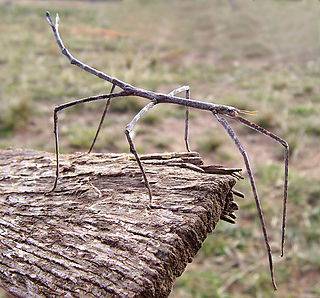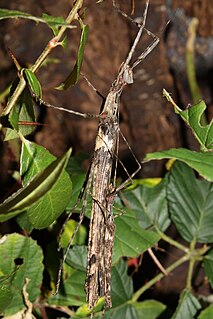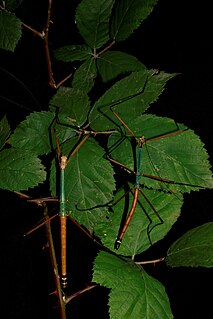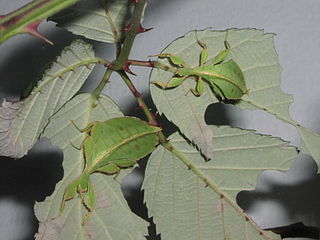
Extatosoma is a genus of phasmids, in the monotypic subfamily Extatosomatinae, with two species. One occurs in Australia, one in New Guinea. Both have a colour morph imitating leaves, and one imitating lichen.
Mnesilochus is a genus of stick insects in the subfamily Lonchodinae. Species have a known distribution in: Borneo, Philippines, Sumatra.

The Phasmatinae are a subfamily of stick insects in the family Phasmatidae. They contain at least three tribes; Bradley and Galil corrected the spelling to "Phasmatinae" and provides a key to tribes.
Acromantis oligoneura is a species of praying mantis the family Hymenopodidae described by Wilhelm de Haan in 1842. No subspecies are listed.

Prisopus is a genus of stick insects belonging to the family Prisopodidae. These stick insects are present in Central and South America, India and Malesia.

Phasma is an Australasian genus of stick insects in the family Phasmatidae, subfamily Phasmatinae and tribe Phasmatini.

Sipyloidea is a genus of stick insects of the family Lonchodidae. The genus was described by Brunner von Wattenwyl in 1893.
Haplopus is a genus of walkingsticks in the family Phasmatidae. There are about seven described species in Haplopus.
Oxyartes is a genus of stick insects in the family Diapheromeridae and subfamily Necrosciinae; species records are from India through to Indochina.

Trachythorax is an Asian genus of stick insects in the family Lonchodidae and subfamily Necrosciinae. Species have been recorded from the Indian subcontinent, Indo-China, Malesia through to New Guinea.

Lopaphus is an Asian genus of stick insects in the family Diapheromeridae and subfamily Necrosciinae. Species have been recorded from India, China and South-East Asia.

Pylaemenes is a genus of stick insects in the family Heteropterygidae and subfamily Dataminae. It combines small to medium-sized, often brightly colored Phasmatodea species. Their representatives are found in large parts of Southeast Asia.
Monticomorpha is a genus of striped walkingsticks in the family Pseudophasmatidae. There are 8 described species in Monticomorpha.

Neoclides is an Asian genus of stick insects in the family Diapheromeridae, subfamily Necrosciinae. Species have a known distribution from: Indo-China, Borneo, Sumatra, Philippines and New Guinea.
Medauromorpha is an Asian genus of stick insects in the family Phasmatidae, subfamily Clitumninae and tribe Medaurini. Species have a known distribution from Vietnam and southern China.

Cryptophyllium is a new (2021) genus of leaf insects in the tribe Phylliini. The current distribution is probably incomplete, but includes southern China, Sri Lanka, Indo-China, Malesia and western Pacific islands.

Cryptophyllium celebicum is type species of leaf insect in the new (2021) genus Cryptophyllium, which has been placed the tribe Phylliini. Its recorded distribution is Sulawesi and Ambon Island.
Astyliasula is a genus of mantises belonging to the family Hymenopodidae.

Coptocercus crucigerus is a species of beetle in the family Cerambycidae, first described by Frederick William Hope in 1842 as Stenochorus cruciger, from a specimen collected in Port Essington (Darwin). In 1929, Herbert James Carter assigned the species to the genus Coptocercus, and also synonymised it with Phoracantha politaPascoe, 1863.

Phasma gigas is a large-sized stick insect found in Maluku Islands, Sulawesi, Gorong Islands and Kei Islands. It is often believed that Phasma gigas is present on New Guinea, but in fact, all New Guinean records actually refer to Phasma reinwardtii. Furthermore, the historic records from Sulawesi are doubtful and need more evaluation.











